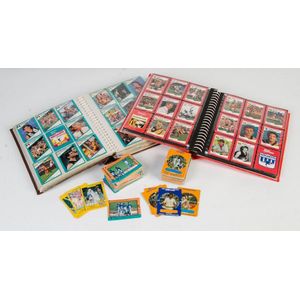Gilt bronze Padmasambhava figure with kapala and dorje
A Tibetan gilt bronze figure of Padmasambhava, circa 15th/16th century, the well modelled figure with a bright, penetrating gaze beneath brows knitted in concentration, with a benign smile. His characteristic hat has an unusual decoration of five heaped 'Norbu' jewels. He wears heavy pendant earrings on elongated lobes, his undergarment held together at the breast by a jewelled fastening chain, his patchwork outer robe bordered with an incised foliate design around his shoulders. In his gracefully modelled left hand he holds a dorje to his breast, his right hand holding a kapala from which issues jewels in a flame like vapour. He sits in dhyanasana on a later double lotus base. He has a katvanga ritual staff held to his shoulder which is not original to the piece., 25.5 cm high, 20 cm wide. Provenance: Soo Tze Oriental Antiques, 2006. Exhibitions: Exhibited Perc Tucker gallery, Townsville, August-November 2003, Pathway to Enlightenment.
You must be a subscriber, and be logged in to view price and dealer details.
Subscribe Now to view actual auction price for this item
When you subscribe, you have the option of setting the currency in which to display prices to $Au, $US, $NZ or Stg.
This item has been sold, and the description, image and price are for reference purposes only.
- Circa - A Latin term meaning 'about', often used in the antique trade to give an approximate date for the piece, usually considered to be five years on either side of the circa year. Thus, circa 1900 means the piece was made about 1900, probably between 1895 and 1905. The expression is sometimes abbreviated to c.1900.
- Foliate - Decorated with leaves or leaf-like forms.
- Incised - A record of a name, date or inscription, or a decoration scratched into a surface, usually of a glass or ceramic item with a blunt instrument to make a coarse indentation. Compare with engraving where the surface is cut with a sharp instrument such as a metal needle or rotating tool to achieve a fine indentation.
- Bronze - An alloy of copper and tin, traditionally in the proportions of about 9 parts of copper to 1 part of tin.
The discovery of bronze in Western Asia in the 4th century enabled people to create metal objects which were superior to those previoulsy possible because of its strength and hardness, and it has been used throughout the world for weapons, coins, tools, statuary and other decorative items.
It is very fluid in a molten state, and its hardness, strength when set, and non-corrosive properties makes it most suitable for casting sculpture.
This item has been included into following indexes:
Visually similar items

Sports Cards: c1990's football & cricket cards (300+) in 3 albums plus some loose, mainly Scanlens (Stimorol)
Sold by
in
for
You can display prices in $Au, $US, $NZ or Stg.

Pair Chinese celadon boy and girl figures. Glazed with blue clothing. Republic period. Height 13 cm (each )
Sold by
in
for
You can display prices in $Au, $US, $NZ or Stg.

A Chinese cloisonne lidded jar of fat baluster form with intricate floral pattern on a pale green ground. Width 15 cm
Sold by
in
for
You can display prices in $Au, $US, $NZ or Stg.

Van Treight Georgian style sideboard in Sheridan style. 169 cm high
Sold by
in
for
You can display prices in $Au, $US, $NZ or Stg.
